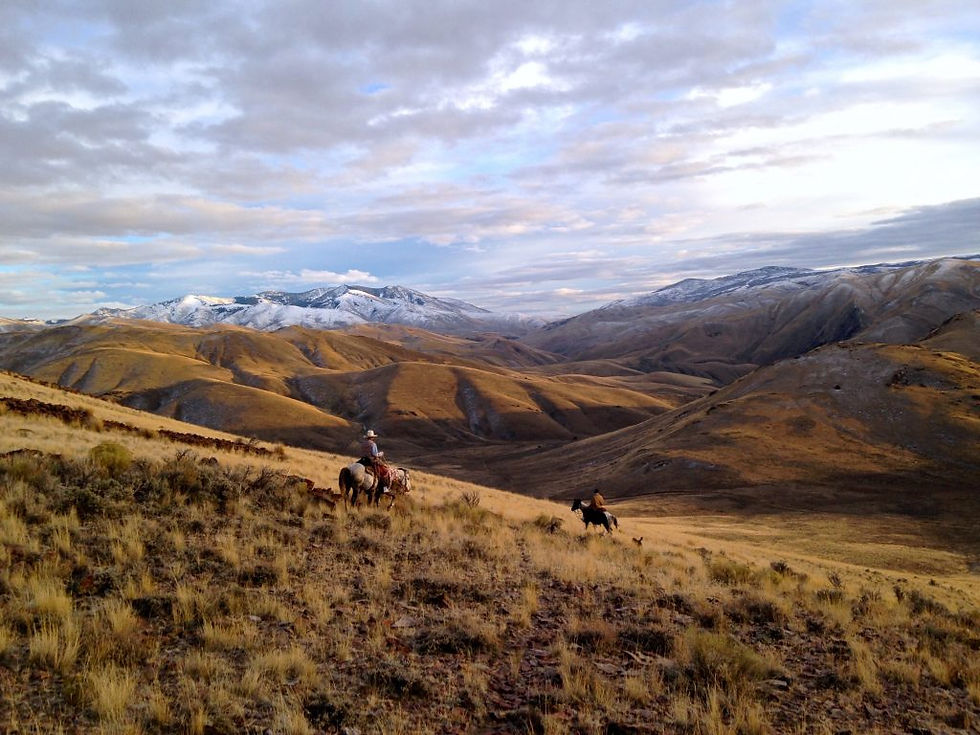ONE WAY TO RAISE CATTLE WITHOUT OWNING A RANCH
- Ceily Rae

- Apr 19, 2017
- 4 min read
The Diversity of Nevada’s Rangeland As per request: the article I wrote for Nevada Rancher April Issue!

One of the great things about Nevada is the abundance of its grazing land. There are many acres of private ground that cover its landscape keeping that land in the ranching tradition. For some however, the possibility of owning an actual ranch can be out of the question.
FORTUNATELY THERE ARE OTHER METHODS OF RAISING CATTLE and making a profit in the cattle industry. Many ranchers rely on using small chunks of deeded ground linked to private or government leases to graze their cattle. The use of leases makes it possible to follow the grass based on the season and one of the perks of Nevada’s climate is that it allows for grazing year round within the state, potentially limiting the need to feed hay depending on the severity of the winter months.
THIS METHOD DOES HOWEVER MAKE FOR A NOMADIC LIFESTYLE, moving from camp to camp based on where your leases are located. The following photographs and broad range overviews are of four separate camps that showcase the diversity of Nevada’s rangeland through my own personal experience of living life as a nomad chasing the seasons!

North Eastern Nevada Summer Pasture
If you were to drive north out of Elko on the Mountain City Highway on your way to Idaho, you

would find country dotted with little towns, ranches, and old homesteads. The terrain is steep with large grass covered hills the size of small mountains, deep cut rocky canyons with junipers, willows, elderberry, chokecherry and, on good years, water in most of the bottoms. The summers are hot and the winters cold, ensuring its status as seasonal pasture. Being in the higher elevations of the Northern Great Basin, vegetation consists of higher elevation plants varying to sagebrush grassland plant communities. There are shrubs like Mountain Mahogany, sagebrush, and some Morman tea. Range grasses include Idaho fescue, Great Basin wildrye, squirrel tail, prairie june grass, Indian rice grass, Snake River wheatgrass, and Thurbers needlegrass.
Mid Central Nevada Summer Pasture

Head further west on the Loneliest Highway 50 to Middlegate Nevada, you will pass through sagebrush grasslands and dry lakebeds surrounded by steep higher elevation mountains that rise out of the valley floors. Hot in the summer, the higher and middle elevations stay cold and snowy during the winters, making this ideal summer range conditions for grazing. Water can be limited so hauling water from larger sources is a necessity. In the flats the predominate plants will be a variety of sagebrush, creosote, rabbit brush, edible; white sage, bud sage, Great Basin wildrye, western wheatgrass, Sandburg bluegrass, Indian rice grass and desert needle grass. In the higher elevations you will start to see Mountain Mahogony, Morman tea, juniper and pinyon pine.
Western Central Nevada Winter Pasture

Not quite to Reno and west of Fallon’s banana belt near Fernley, Silversprings, and Stagecoach, the land warms up and the sightings of feral horses increases. Unless it happens to be a harsh year, ranchers can usually winter their cattle successfully, it requires a large amount of acreage and lots of water hauling. Droughts can decrease range condition and the biggest competition for range feed is the large herds of feral horses problematic of lots of Nevada’s grazing land. These desert shrublands consist of; sagebrush, creosote, prickly pear cactus and edible; kochia, desert needle grass, white sage, bud sage, shadscale, fiddleneck, and four wing salt brush.
Southern Nevada Winter Pasture
Another great winter range area is Nevada’s southern end of the Great Basin. Approaching

and overlapping the Mojave Basin and Range, the most iconic feature in the change of scenery is the presence of Joshua trees, which are characteristic of the Mojave. Water is limited but by hauling or pipelining, water doesn’t become much of an issue if managed correctly. Typical of the rest of the state, the landscape rises out of low elevation sagebrush and alkaline flats into high elevation mountainous fingers dividing the valleys. You will see a variety of low elevation and higher elevation plant life including; sagebrush, rabbit brush, cholla cactus, prickly pear cactus, yucca, and edible; Morman tea, bud sage, white sage, four wing salt brush, spiny hopsage, penstemon, dwarf buckwheat, galleta, desert needle grass, and Indian rice grass.
These camps are just a narrow cross section of Nevada’s vast range lands
Their locations however, do a decent job of showcasing the flexibility a cattle rancher can have in the State of Nevada or in other states as well, owning a ranch or not! There is much of the Great Basin Range that I have yet to see fat cattle grazing on and a camp living being made on. To me, this land is how our lifestyle survives and regardless of where camp is being made, I strive to always be a good steward of it so that it continues for future generations.
Until next time, remember that there are other options besides owning a ranch to be involved with raising livestock and some states like Nevada have diversity year round! Ceily Rae Highberger

All photos in this blog post taken with my Sony Alpha 6000 and iPhone 6s



Comments